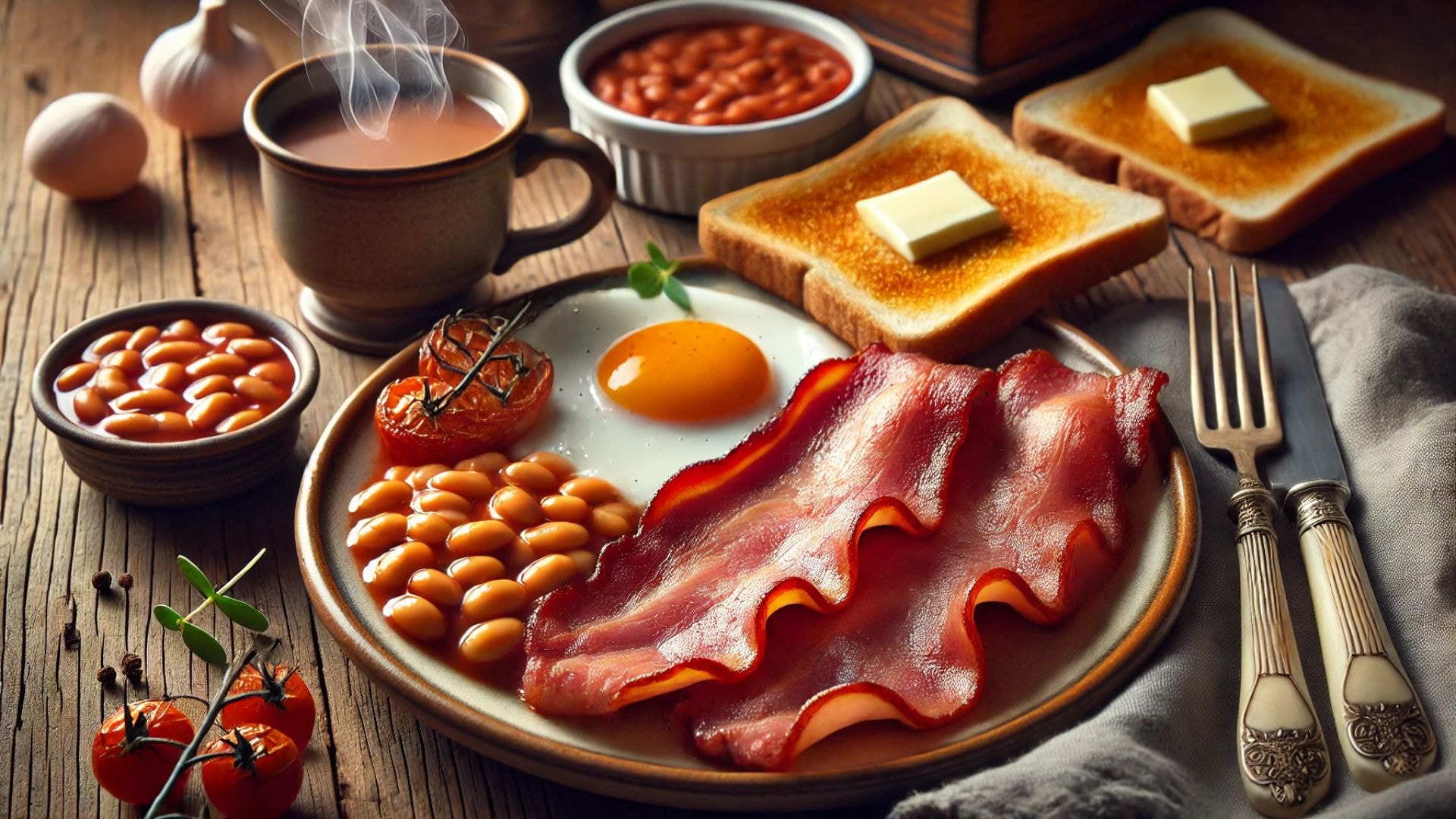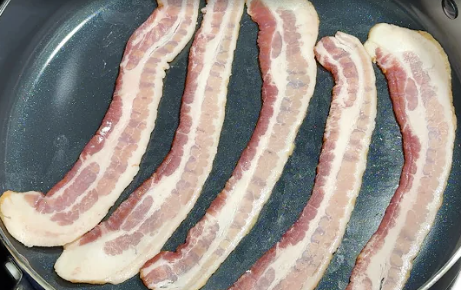
Rashers in Ireland refer to slices of bacon that are traditionally thicker and less fatty than the typical American style bacon. Unlike the crispy strips often found in the United States, Irish rashers are made from the pork belly or loin and are cut to include a larger portion of meat relative to fat. This makes them juicier and more flavorful, ideal for frying or grilling. They are a staple in the traditional Irish breakfast, often served alongside eggs, sausages, and black pudding.
Types of Rashers in Ireland
In Ireland, the main types of rashers you'll find are Back Rashers, Streaky Rashers, Dry-Cured and Wet-Cured Rashers. Rashers, which are slices of bacon from the pig, are a crucial element of the traditional Irish breakfast. Back Rashers are cut from the loin and are notably leaner, while Streaky Rashers come from the belly and feature a higher fat content that adds richness. The difference between Dry-Cured and Wet-Cured Rashers centers on their curing processes, which significantly influences their flavor and texture. Each type of rasher offers a unique taste and cooking characteristic that enhances a variety of Irish dishes.
Back Rashers

In Ireland, rashers refer to a type of bacon that is a staple in many breakfast dishes. Back rashers, in particular, come from the loin in the middle of the back of the pig, which makes them leaner and meatier compared to other types. This variety is similar to what is known as Canadian bacon in North America, offering a thicker and more substantial cut. The flavor of back rashers is distinctively mild and they are usually cured, giving them a slight saltiness that enhances their taste.
These rashers are not only cherished for their quality but also for their versatility in traditional Irish cuisine. They can be found in everything from the classic full Irish breakfast to various sandwiches and even incorporated into some traditional Irish dinners. The method of preparation typically involves frying or grilling, which brings out their natural flavors and gives them a satisfying texture that is both crispy and tender.
-
Preparation: Typically fried or grilled to achieve a crispy exterior while retaining a tender interior.
-
Serving suggestions: Often served alongside eggs, sausages, and black pudding in a full Irish breakfast.
-
Culinary uses: Commonly used in sandwiches or diced in salads and pasta dishes for added protein.
-
Availability: Widely available in supermarkets and butchers across Ireland.
Following the cooking, back rashers can be enjoyed in a variety of dishes. They are particularly popular in breakfast rolls, which combine them with sausages, eggs, and sauces in a soft bread roll—a favorite for on-the-go meals. In more formal dining, back rashers enhance the flavor profile of creamy pasta dishes or are served as a hearty side with pancakes and maple syrup.
Their popularity ensures that back rashers are a common sight in Irish homes and restaurants alike. The traditional methods of curing and cooking these rashers have been passed down through generations, making them a beloved part of the culinary heritage in Ireland. Whether as part of a luxurious weekend breakfast or a simple weekday dinner, back rashers remain a versatile and cherished ingredient in the Irish kitchen.
Streaky Rashers
Streaky rashers are a popular type of bacon known for their characteristic strips of fat running parallel to the meat. These rashers come from the belly of the pig, where the fat content is higher, providing a richer flavor and crispier texture upon cooking. Streaky rashers are often favored for their versatility in cooking, as they can be fried to a crispy finish or added to various dishes for added depth of flavor. However, certain foods, including streaky rashers, may be on the list of foods to avoid in Ireland depending on dietary preferences or restrictions.
The preparation of streaky rashers involves curing the meat with salt and sometimes additional flavorings like sugar and spices, enhancing its taste and preservation. This process results in a savory, meaty product with a robust flavor profile, which is a staple in traditional Irish breakfasts. Streaky rashers are typically thinner than other types of bacon, allowing for quick cooking and a satisfyingly crunchy texture when fried.
-
Cooking Techniques: Ideal for frying or grilling to achieve a crispy texture.
-
Culinary Uses: Commonly used in full Irish breakfasts, sandwiches, and as a flavorful addition to recipes like pasta and soups.
After cooking, streaky rashers exhibit a delightful contrast between the crispy edges and the tender meat. Their ability to hold up well under high heat makes them perfect for adding a crunchy element to dishes. In Ireland, these rashers are not just breakfast fare but are also incorporated into various meals, reflecting the local cuisine's hearty and home-cooked ethos.
Moreover, the popularity of streaky rashers extends beyond their taste. They represent a culinary tradition in Ireland, often enjoyed in homes and restaurants alike. Whether served alongside eggs and toast for breakfast or wrapped around a piece of chicken for dinner, streaky rashers are a beloved part of the Irish food landscape, cherished for their flavor and versatility.
Dry-Cured vs. Wet-Cured Rashers
Dry-cured rashers are made by rubbing salt and other seasonings directly onto the meat, allowing it to absorb the flavors gradually. This method removes moisture naturally, concentrating the bacon's flavor and resulting in a firmer texture. This traditional technique eschews the use of added water, leading to less shrinkage during cooking and a richer taste, much like capturing the essence of travel through creative travel journaling.
Conversely, wet-cured rashers are soaked in a brine solution containing salt, sugar, and various seasonings. This process is quicker than dry-curing and adds moisture to the meat, making the rashers more tender and mild when cooked. However, because of the added water, these rashers may shrink more during cooking, which can affect the texture and overall yield of the bacon.
-
Dry-Cured Rashers: Offer a robust flavor, ideal for frying or grilling; preferred for their less watery cookout.
-
Wet-Cured Rashers: Milder in taste; often found in packaged bacon products in supermarkets; known for their tender texture.
Choosing between dry-cured and wet-cured rashers in Ireland largely depends on personal preference and cooking application. Dry-cured rashers, with their intense flavor, are particularly prized in traditional Irish breakfasts and for recipes where bacon is a standout ingredient. They are favored in culinary settings where a crispy, dense texture is desired.
On the other hand, wet-cured rashers are often appreciated for their versatility and ease of use, making them a common choice for everyday cooking. They cook quicker and are more readily available, which suits fast-paced lifestyles without sacrificing the beloved taste of Irish bacon. When selecting rashers, consider how the bacon's flavor and texture can complement your dish, whether it's a hearty breakfast or a flavorful component in sandwiches and salads.
How Rashers Differ from American Bacon?
Rashers differ from American bacon primarily in their cut and preparation. In Ireland, rashers are a staple of the traditional breakfast and are derived from the back of the pig, resulting in a meatier and less fatty product compared to American bacon. This difference in cut also influences the texture and cooking methods used. While American bacon is known for its crispiness, Irish rashers are typically cooked until just firm, offering a different culinary experience that highlights the pork's natural flavors without overwhelming crispness.
The curing process also sets them apart. American bacon is often cured with a mix of salt and sugar and then smoked, giving it a distinctive sweet and smoky flavor. On the other hand, Irish rashers are usually cured in a simpler salt brine and are not typically smoked, resulting in a more subtle and pork-forward taste. This method focuses on enhancing the natural taste of the pork without the infusion of smoke or additional sweet flavors, making rashers a unique item on the Irish breakfast plate.
Differences between Irish Rashers and American Bacon:
-
Cut: Rashers come from the back of the pig, while American bacon is cut from the belly.
-
Fat Content: Rashers have less fat and are meatier compared to the fatty, streaky American bacon.
-
Flavor: Rashers are subtly salted and not smoked, whereas American bacon has a pronounced smoky and sweet flavor due to its curing process.
While both types of bacon hold a beloved place in their respective cuisines, the differences between rashers and American bacon highlight diverse culinary traditions and preferences. In Ireland, the preference for rashers reflects a taste for naturally flavored meats with less emphasis on fattiness and smoke. This choice complements the array of other breakfast items such as black pudding and sausages. Meanwhile, in the U.S., the crisp, rich flavors of bacon embody the American penchant for bold and diverse taste profiles, often enjoyed in a variety of dishes beyond just breakfast. Thus, whether it’s rashers or American bacon, each offers a unique slice of its home country’s culinary culture.
What is the History of Rashers in Ireland?
The history of rashers in Ireland dates back to traditional Irish farming practices. Rashers, which are thinly sliced pieces of bacon typically cut for quick cooking, became a staple in the Irish diet due to the widespread farming of pigs, which provided a reliable source of meat. Irish rashers are known for their rich flavor, a result of the local curing methods that have been refined over centuries.
This process typically involves salt curing the pork, which preserves the meat and enhances its taste. Today, rashers are a key component of the traditional Irish breakfast, often served alongside sausage, white pudding, and brown sauce, creating a delicious meal that symbolizes a culinary tradition continuing to hold a special place in Irish culture and cuisine.
What is the Cultural Significance of Rashers in Irish Cuisine?
The cultural significance of rashers in Irish cuisine is profound and enduring. Rashers, essentially Irish bacon, are not just a staple at breakfast but a symbol of Irish hospitality and comfort. This cured meat, integral to both the traditional Irish breakfast and English breakfast, is served alongside eggs, sausages, mushrooms, and black pudding, offering a hearty start to the day that is cherished across Ireland and beyond.
Traditionally, rashers represent more than just sustenance; they embody a connection to Irish agricultural practices and local farming. Their presence on the breakfast table evokes a sense of nostalgia and familial warmth, making them a culinary icon in Irish households. Celebrated in family gatherings and local eateries alike, rashers hold a special place in the heart of Irish cultural identity, signifying not just a meal but a shared heritage.
How Are Irish Rashers Prepared?
Irish rashers are prepared with a distinct method that highlights their unique flavor and texture. Traditionally sourced from the back cuts of pork, these rashers differ from typical American bacon, which comes from the pork belly. The preparation involves curing the pork with a mix of salt, sugar, and sometimes spices, ensuring the meat is infused with flavor while retaining its moisture.
-
Curing: The pork is first cured with a dry rub of salt and sugar, and sometimes spices, for several days.
-
Rinsing: After curing, the pork is thoroughly rinsed under cold water to remove excess salt.
-
Drying: The meat is then air-dried or slightly smoked to develop its flavor and preserve the meat.
-
Slicing: Finally, the pork is cut into thin slices, making sure each piece has a perfect balance of meat and fat.
Once prepared, Irish rashers offer a robust flavor that is less salty and more meaty than their American counterparts. They are typically pan-fried until golden and slightly crispy on the edges, making them a beloved component of the traditional Irish breakfast. This preparation not only preserves the pork’s natural flavors but also enhances them, providing a hearty and satisfying addition to any meal.
Where To Buy Authentic Irish Rashers?
To buy authentic Irish rashers, you can visit several specific places that specialize in Irish foods. Rashers, which are essentially Irish bacon, are a staple in traditional Irish breakfasts and are known for their rich flavor and slightly different cut compared to American bacon. These can be found in both local and international markets that carry Irish products.
Where to buy authentic Irish rashers:
-
Local Irish butchers and specialty shops: These establishments often offer the most traditional cuts.
-
Irish goods stores abroad: Look for shops that import Irish food products.
-
Online retailers specializing in Irish foods: Websites like FoodIreland.com offer a variety of rashers that can be delivered directly to your home.
-
Large supermarkets with international sections: Some global chains carry Irish rashers, especially in areas with a significant Irish expatriate community.
Purchasing Irish rashers from these sources ensures you get the genuine taste of Ireland. Whether you're preparing a full Irish breakfast or just want to enjoy the unique flavor of rashers, these outlets provide access to authentic Irish culinary experiences right from the comfort of your home. Be sure to check the origin on packaging to confirm authenticity.
Tips for Selecting the Best Rashers
When selecting the best rashers in Ireland, it's important to know what you're looking for. Rashers, a traditional Irish bacon, come from the pork loin or belly and are known for their rich flavor and meaty texture. Choosing high-quality rashers can elevate any breakfast plate.
-
Opt for thick-cut rashers: These retain more moisture during cooking, offering a juicier bite.
-
Look for a good meat-to-fat ratio: Ideal rashers should have a balanced marbling of fat, enhancing their flavor.
-
Check the curing process: Traditional dry-cured rashers have a more robust taste compared to wet-cured ones.
-
Source locally: Irish pork is renowned for its quality. Local butchers often provide the freshest options.
After purchasing the best rashers, proper preparation can make all the difference. Cooking them on a medium heat allows the fat to render slowly, crisping the edges without drying out the meat. Pairing them with fresh, local eggs and homemade soda bread can transform a simple meal into a traditional Irish feast. Enjoying quality rashers is not just about taste but also about embracing a slice of Irish culinary heritage.
FAQs On What Are Rashers in Ireland
1. What are rashers in Ireland?
Rashers in Ireland refer to slices of bacon, typically from the back of a pig, which are thicker and meatier than the streaky bacon found in other regions. They are a staple in the traditional Irish breakfast, often enjoyed fried or grilled.
2. How are rashers typically prepared in Ireland?
Rashers are commonly grilled or fried until they are crispy. They are a key ingredient in various dishes, including the full Irish breakfast, alongside sausages, eggs, and black pudding.
3. What distinguishes Irish rashers from American bacon?
Irish rashers are cut from the back of the pig, making them leaner and thicker compared to the American bacon which is cut from the pork belly and is thinner and fattier. This difference in cut leads to a variation in texture and flavor.
4. Can you substitute rashers with other types of bacon?
While you can substitute rashers with other types of bacon, the flavor and texture will vary. For an authentic taste of Irish cuisine, it is best to use traditional Irish rashers.
5. Are rashers only used in breakfast dishes in Ireland?
No, rashers are not limited to breakfast dishes in Ireland. They are versatile and can be used in sandwiches, wrapped around other meats or vegetables, and incorporated into various recipes to enhance flavor and add a robust, savory element.
